
From July 19th to September 5th 2004
The present exhibition is the most comprehensive to date devoted
to the Andalusian paintings in the Carmen Thyssen-Bornemisza Collection.
It brings together more than 92 works dating from the second third
of the 19th century to the early years of the 20th, offering a broad
panorama of Andalusian painting from Romanticism to Regionalism.
Following a period of decline after the death of Murillo and the predominance of foreign artists at the court of the early Bourbon monarchs, the 19th century saw a new flourishing of painting in Andalusia, resulting in one of its most productive eras. From the 1830s onwards, Seville and other capitals of the region witnessed a notable economic revival. More important, however, was the arrival in Andalusia of foreign travellers from England and elsewhere in Europe. These early "tourists" had first started to arrive in Spain in the late 18th century. However, it was in the second quarter of the next century that they appeared in large numbers, the result of the repercussions throughout Europe of the Spanish War of Independence (1808-1813) and the new Romantic taste for the exotic. More than any other region, Andalusia represented for these travellers the "Romantic myth of Spain". Seville and Granada in particular welcomed writers and painters such as Washington Irving, Richard Ford, Théophile Gautier, Alexandre Dumas, David Roberts, John Frederick Lewis, Alfred Dehodencq, Gustave Doré and others, whose work established the image of "picturesque Spain". This was accompanied by a growing demand abroad for paintings depicting the principal landscapes, monuments and popular customs of southern Spain.
|
  |
 |
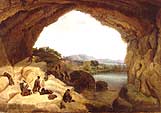 |
Room 1. ROMANTIC LANDSCAPE PAINTING
The local Andalusian painters looked to the work of some of the above-mentioned artists, as can be seen here in various paintings by Manuel Barrón and José Domínguez Bécquer who remained faithful to models developed by David Roberts. These two Spanish artists are now considered the founders of 19th-century Andalusian painting. Barrón, along with Andrés Cortés, created a type of theatrical landscape which also included anecdotal and folkloric elements.
Manuel Barrón y Carrillo. Bandits Ambushed at the Cueva del Gato. 1869
|
|
| |
 |
Room 2. ROMANTIC COSTUMBRISTA PAINTING
In a quasi-industrial manner, Domínguez Bécquer produced numerous repetitions of small compositions that offered a charming vision of Andalusian life and customs and were much in demand with English buyers. After his early death, his efforts were continued by his cousin, Joaquín Domínguez Bécquer, who became court painter to Isabel II. Other early Andalusian genre painters include Manuel Cabral Aguado Bejarano, Manuel Rodríguez de Guzmán and Ángel María Cortellini.
Joaquin Domínguez Bécquer. The Seville Fair.1867 |
|
| |
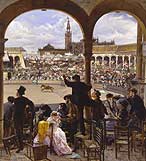 |
Room 3. LATE COSTUMBRISTA PAINTING
This type of genre or costumbrista painting lasted in Andalusia until the late 19th century, reflecting ever more closely the tastes of a local petit bourgeois clientele. The late works of José Jiménez Aranda, José García Ramos, Manuel Wssel de Guimbarda, Joaquín Turina and José Rico Cejudo draw on the earlier interest in popular types but in combination with a more detailed observation of the figures and urban setting, the result of French Realist influence.
José Jiménez Aranda. Incident in a Bullring.1870
|
|
| |
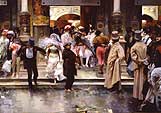 |
Room 4. PRECIOSISTA PAINTING
A key event in the development of 19th-century Andalusian painting was Mariano Fortuny and Martín Rico's stay in Seville and Granada in 1871. Their preciosista paintings, also imbued with the new interest in luminism, would be important for artists such as Jiménez Aranda and García Ramos, as well as José Moreno Carbonero, Salvador Sánchez Barbudo and Antonio Reyna, all represented in this exhibition.
José García Ramos. Leaving a Masked Ball. 1905 |
|
| |
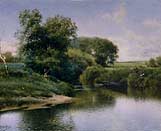 |
Room 5. LATE LANDSCAPE PAINTING
Another artist associated with Fortuny in his early period was the Sevillian Emilio Sánchez Perrier. In the early 1880s, Sánchez Perrier became familiar with the work of Corot and the Barbizon painters in Paris, with the result that his work became notably more naturalistic. On his return to Spain, he founded a landscape painters' colony in Alcalá de Guadaira near Seville, where he was joined by Jiménez Aranda and Manuel García Rodríguez. Andalusian landscape painting of the late 19th century was also influenced by the teachings of Carlos de Haes through the figure of Emilio Ocón. Trained in Madrid with Haes, Ocón became the leader of an entire generation of Malaga painters specialising in marine views, notably Guillermo Gómez Gil and Ricardo Verdugo Landi.
Emilio Sánchez Perrier. A Stroll along the River Bank. c. 1890
|
|
| |
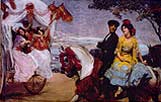 |
Room 6. THE TURN OF THE CENTURY AND MODERN ART
The late 19th and early 20th century saw a rethinking of the particular identity of Andalusian art in the light of new international movements such as Impressionism, Symbolism and Fauvism. The result was the trend known as Regionalism, represented by artists such as José María López Mezquita, José María Rodríguez-Acosta, Gonzalo Bilbao, Gustavo Bacarisas and Julio Romero de Torres.
Gonzalo Bilbao. Country Pilgrimage. c. 1915 |
|
| |
|
|
  |